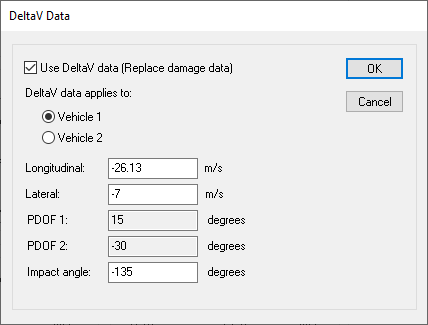AiDamage has been enhanced with a new tool. This tool, ‘Replace DeltaV’ does just that – it allows the user to replace the calculated damage DeltaV for either vehicle with a user defined DeltaV. Since the masses of each vehicle have already been defined, the DeltaV of the other vehicle can easily be determined. Using the same techniques as described elsewhere, the Predicted Speed algorithm can then be used to determine the actual speeds of the vehicles at impact. Similarly the Points of Interest routines can be used to find the DeltaV at any point within either vehicle.

Longitudinal and lateral DeltaV components at the centre of mass are required which enables the PDOF for that vehicle to be defined. The PDOF for the other vehicle is automatically calculated from the user defined angle between the two vehicles at impact.
There is no restriction as to how the replacement DeltaV might be derived. It was designed to be used from data derived from Collision Data Recorders (CDR), but could equally be derived from any other method. The DeltaV from only one vehicle is required as the DeltaV of the other vehicle can be calculated.
A major advantage to this new tool is that it removes any dependence on the crush damage calculations and as such any reliance on stiffness coefficients. The predicted speed algorithm and points of interest rely on the conservation of linear and rotational momentum and the method of calculating DeltaV as input to either of those algorithms is irrelevant.
The position of the point of application of the impulse on each vehicle is still important and is normally defined from the crush damage profile. This parameter is important in the calculation of the predicted speed. As has been the case for a number of years, the calculated point of application can be overriden using the Amend Collision pages.
